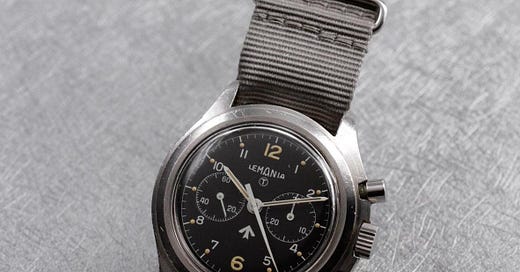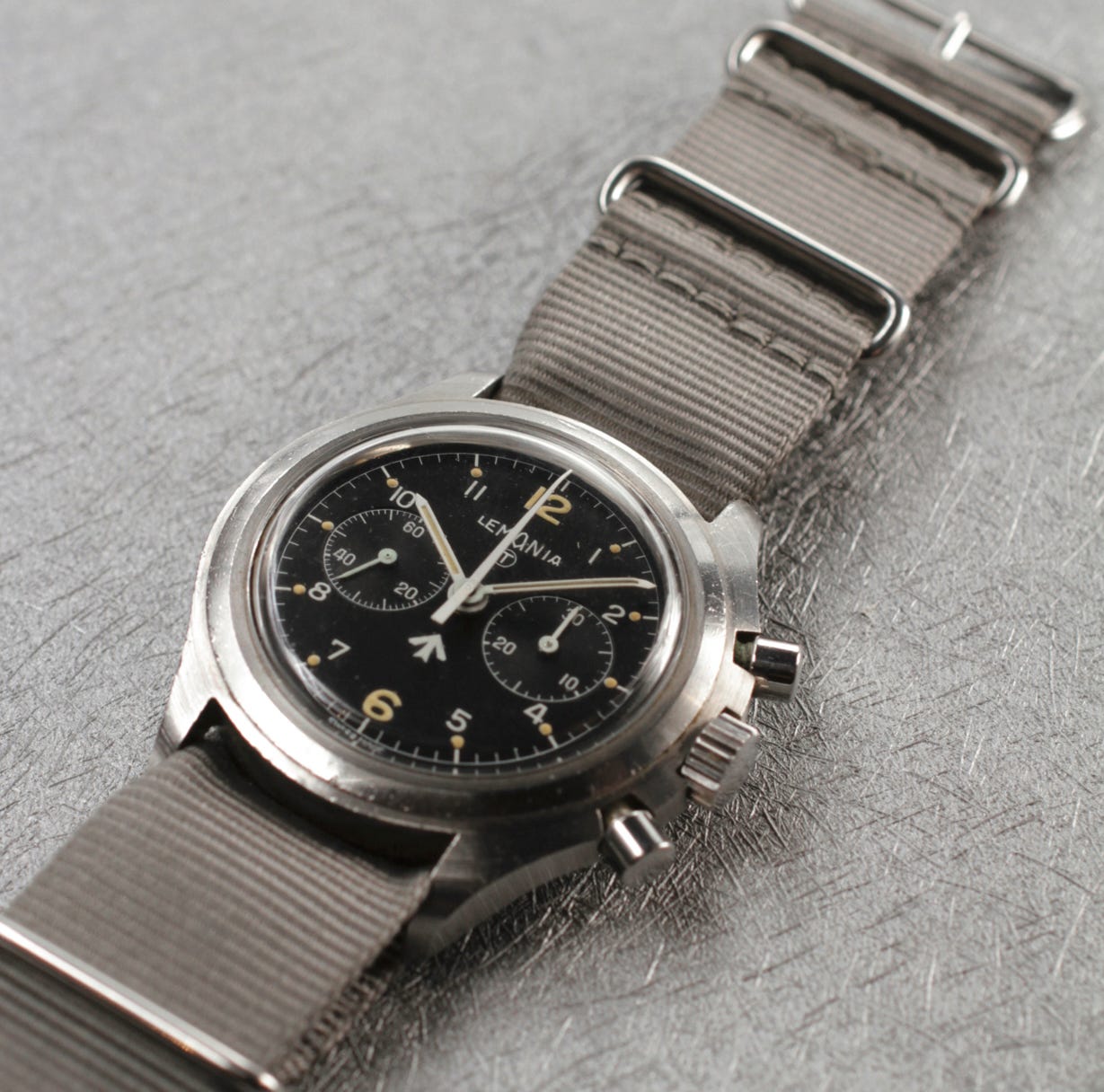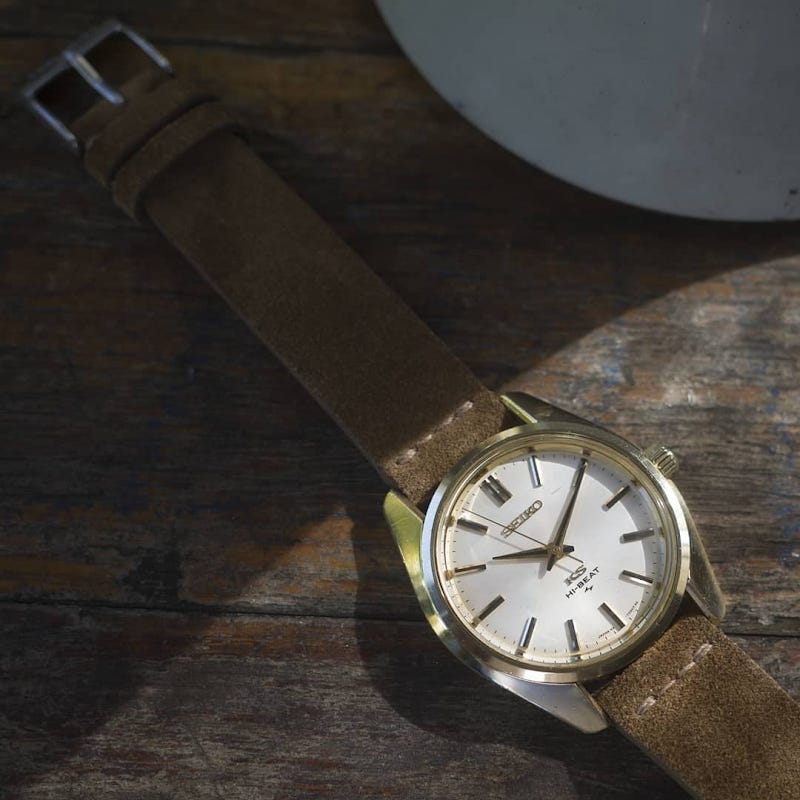What this military chronograph tells us about watches in 2021
Did Elon Musk tweet about the 5711 yet?
This issue is kind of an op-ed page, with three contributor articles from the week: (1) 11 lessons from a year of watch collecting; (2) 5 tips to make your watch photography better; and (3) a fan’s (and guitarist’s) perspective on the John Mayer G-Shock. Check them out below.
Meanwhile, I tuned into Boule’s watches auction in Monte Carlo on Thursday to listen to an auctioneer shout numbers in French for a few hours. A Nautilus 5711 hammered for soixante dix huit mille (€78k). Adding a 25% buyer’s premium, it seems we’re firmly in six-figure U.S. dollar territory for the Nautilus, for now at least. Is this peak Elon tweeting “GameStonk!”, sending it to a high before crashing back to Earth, or only the beginning of the frothiness? It’s more than that €60k hammer we saw at Aniquorum a couple weeks back, though the Boule 5711 may have been in better condition. Hard for me to say — I’m enjoying 10-degree temps in the American Midwest while the 5711 is thousands of miles away on a yacht in Monaco.
Looking past the watch that’s more detached from reality than Paris Hilton c. 2005, I wanted to highlight one more lot that performed well.
Lemania mania
A Lemania ref. 818 two-button chronograph for the British Royal Navy sold for about $10k all-in. This military Lemania chronograph doesn’t have much in common with the aforementioned Nautilus (and thank goodness). It was introduced a year before the first Nautilus ref. 3700 (1975), but in many ways, the Lemania’s got more going for it. It was extremely limited in production — only 500 were produced from 1975-76 (250 per year), it’s from the chronograph manufacturer that was making movements for pretty much everyone back then, and there’s that military provenance.
For dozens of years, Lemania made single-pusher chronographs for the British Ministry of Defense. But in the early 70s, the MoD updated its standards, allowing for two-button chronographs. So in 1975-76 Lemania produced this two-pusher model. Producing just 500 in total, this thing is rarer than pretty much any Nautilus that’s not made of platinum.
These ref. 818 chronographs were mostly destined for the Fleet Air Arm of the UK’s Royal Navy. There’s something raw and unadulterated about a Lemania chronograph made for the military. Sure, Lemania calibers were serving as the base for chronographs from Omega, Patek, and others for years, but a mil-spec Lemania for the British MoD just feels pure, stripping everything away to deliver only what’s absolutely necessary for a Royal Navy pilot. Namely, that’s a caliber 1872 inside a large, tough 40mm steel asymmetrical case. Like, those guys copping highly-decorated Patek perpetual calendars with a Lemania base were the ones compensating for the fact that they’d never be able to get their hands on this watch, not the other way around.
In fact, this same example sold for just ~$3.3k back in 2019, so it’s a nice increase for this particular watch in just a couple years. It’s part of a steady upward price trend we’ve seen in the few ref. 818 examples that have come up for sale over the past few years.1
Often, we focus on booming prices of high-profile watches from Patek, Journe, and others, debating the unanswerable ‘is it a bubble?’ But this conversation ignores the steady price increases of real “collector’s watches”2 like this Lemania, which illustrate just how deep and strong the watch market is.
The Simple Life
Elsewhere, this Patek 1463 in yellow gold headlined Christie’s Dolce Vita sale, selling for €87.5k. This example’s got an interesting recent history too: It sold for €110k at auction back in 2019 before passing at Artcurial in 2020 where it had a healthy €110-150k estimate (damn flippers!). In other words, a yellow gold Tasti Tondi — a watch that no less than Wei Koh has called the green light at the end of the dock to his Gatsby — can cost less than a ref. 5711 right now. As a reminder, there were maybe 750 Tasti Tondis ever produced; there are literally about half that many 5711s on Chrono24 right now. Now that feels about as detached from reality as Paris Hilton.
Rescapement is a weekly newsletter about watches, mostly vintage. Subscribe now to get it delivered to your inbox every Sunday. 👉
11 lessons and tips from my first year of watch collecting
By: Agaki
Picture. It’s the start of 2020. Following a timely raise and to celebrate the new decade (just make up events to justify buying stuff guys, it’s great), I decide to treat myself to an expensive watch: a G-Shock. A few watches later, accelerated by an era-defining global pandemic and with nothing much else to do, I dove into this cursed hobby and here I am a year later writing over a thousand words on watches, for fun. Suffice to say I fell for the watch trap. Here are some observations, lessons, and anecdotes from my first year of collecting shiny things.
1. Don’t buy into the ‘textbook’ watches
The impetus for this upcoming melange of words was my feeling of being cheated by one of Reddit’s more universally recommended watches — the Seiko SARB017 Alpinist. I was (and many newcomers to the watch world are) obsessed with starting off with a watch that could ‘tick all the boxes’. The problem is that when you’re new, you don’t even know what the boxes are! I was gaslighting myself into thinking the words, ‘reliable Seiko 6R15 automatic movement’ weren’t literal gibberish to me. Watches are an anachronism. They have lost the pure function form they were born from. So why do so many of us talk about them as if they have ‘features’? As a new collector, I initially approached this hobby in a totally logical but highly incorrect way — looking for standardized checkmarks I could tick off. After watching about twenty YouTube videos of people reviewing watches, listing water resistance specs as if watches were a smartphone, I bought in. ‘Great watches that YOU can afford!’, ‘INCREDIBLE value!’, ‘Top 10!’.
2. Figuring out what you DON’T want on a watch is easier than figuring out what you DO want
I call this, ‘Big Menu At Restaurant Theory’ (look forward to the scientific paper). It’s far easier to knock off categories of things you don’t want than it is to pick out a singular thing you do want. I learned from my early Seiko Alpinist that I absolutely did not enjoy setting the date. I could look at the date on my damn phone. That was my arbitrary line. Every watch with a date window is now dead to me. This has evolved into only wanting to collect time-only watches.
Draw your own arbitrary lines and come up with your own personal catch-alls. This alleviates a substantial amount of decision fatigue and frustration from your collecting. It will streamline the collecting process immeasurably. Don’t like dive watches? Anything with a bezel is now inconsequential to you. Hate Roman numerals? Pretend every watch with roman numerals doesn’t exist. Tom Brady first surveys the gigantic open field, then eliminates closed passing lanes, and finally narrows into the singular receiver. He doesn’t continually scan the open field because that would waste time, he’d get tackled and I think not getting tackled is the point of American football.
Ironically, Lesson #7 from Agaki is that ‘watch photography is hard.’ Which leads to our next article…
👉 Read the full article here.
5 tips to make your watch photography better with @waitlisted
When I first reached out to James, the man behind the @waitlisted Instagram account, about tips for improving one’s photography, his advice was simple: read, re-read and read again the hundreds of articles Ming Thein has posted on his blog about photography.
“It’s probably the best resource I’m aware of for someone that’s really serious about learning photography,” he said.
Still, I wanted to get some insight into James’ creative process, so we hopped on Clubhouse (yea, I know), to chat watch photography. We went through 5 key parts of photography: equipment, lighting, composition, getting a quality shot, and post-processing.
From James (@waitlisted)
Lighting
While your choice of camera is relatively unimportant, lighting is incredibly important. In fact, it’s pretty much the entire ballgame when it comes to watch photography. Photography in general, and watch photography in particular, is all about light — after all, photography is nothing more than the capture of light. Good lighting makes a good watch photo. In general, you want lighting that is both directional and diffuse: directional because it creates shadows that will lend a photo depth, texture, and context, and diffuse because harsh light sources will blow out highlights and detail (as an aside, this is why watch photos taken on overcast days tend to look more pleasant: the clouds act as a natural diffuser). Minute variations in the angle, intensity, and positioning of your light sources make an enormous difference in the look of a watch photo. One way to appreciate this is to take a bunch of photographs of the same subject with the same composition under different lighting configurations, and observing just how variable the results can be.
Zooming out:
It’s important to have fun. I got into watch photography because I really love watches, I loved staring at them and admiring their beauty, and I wanted to both record that beauty for myself and be able to share what I saw in them with others. That’s still what drives me to keep shooting. Don’t get caught up on external validation in the form of Instagram likes or attention: shoot the photos that make you happy. It’s no secret that Instagram can be a toxic and demotivating place, and while I love Instagram for the opportunity to connect with friends and other members of the watch community, I’ve never sought it as a source of validation or motivation. If I were motivated primarily by Instagram reshares or likes, I’m inclined to think I would have given up a long time ago.
One last note: watch photography isn’t easy — as much as I love it, it can often be extremely frustrating. Even now, I’ll often take 20 or 30 shots before I land on something that I like. Don’t be afraid to experiment, don’t be afraid of getting things wrong, and don’t be afraid to iterate until you get things right. And whenever you do get a shot right, try to isolate what it is that made you like that shot and keep that in mind next time you shoot a watch. Always try to do something a little bit better each time you pick up a camera: it could be big, it could be small, it could be something that people will notice, it could be something that nobody but you will notice. Just keep trying to do something better. Do that often enough and one day, you’ll look back and realize you’ve come quite a bit further from where you started.
👉 Read all 5 tips here.
A fan’s (and guitarist’s) perspective on the John Mayer G-Shock
The construct of the online limited edition drop forbids any thinking before the (figurative) swipe of your credit card. You’re either in or you’re not. And you have to choose there and then. I was in on the John Mayer G-Shock sight unseen, but it was only after thinking it through the next day that I truly felt good about getting the watch. Those 8 minutes before I swiped my credit card and it sold out weren’t enough. But yeah, this is the watch John Mayer would have designed, even if there were no Hodinkee, Instagram, or any of today’s crazy watch internet. I’ve seen virtually every video of him, read or watched each interview, and learned to play all his songs on the guitar for the better part of 20 years — that’s why I’m pretty convinced about it.
👉 Read the full take here.
Through the Wire
🧥 How to source rare vintage menswear online (FT). 👋 LA’s Wanna Buy A Watch? was nice enough to shout us out in its weekly email, so in the name of reciprocity, here’s a nice feature on WBAW’s Ken Jacobs: but please don’t ask him about box & papers. 📚 Speaking of Gatsby, why do we keep reading the Great Gatsby? “Fitzgerald’s made time both a character in the novel and an ingredient in the book’s recipe for eternity” (Gatbsy came out of copyright this year).
—
Rescapement is a weekly newsletter about watches, mostly vintage. Subscribe now to get it delivered to your inbox every Sunday. Follow us on IG too.
One of the last to come up for sale was featured in Hodinkee’s Bring a Loupe (RIP). p.s. I’m so glad Substack supports native footnotes now to indulge my worst writing impulses. And much like our trade show coverage, our graphics department is run by my cat, who’s been learning PowerPoint during quarantine. Don’t worry, he’s already got his press pass for Watches & Wonders 2021.
“Collector’s watch” is truly an insufferable term. But, I’m trying to say that you’ve got to at least do some research to know this Lemania even exists, and then wait around for one to pop up — only a couple come up for sale publicly a year.











Good article, like the watch, recommend others like it